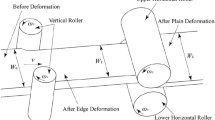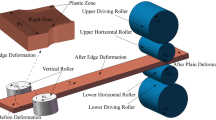Abstract
A mathematical model of vertical rolling process with the consideration of mechanism displacement is proposed. Using Γ function and parabola function to describe edge deformation, the corresponding 3D velocity field, strain rate field and total power functional are derived. Simultaneously, an analysis method of mechanism deformation is proposed. The deflection of vertical roller and the radial displacement of support bearings are calculated by applying superposition principle and Palmgren’s modified formula respectively. The coupling calculation of slab deformation and mechanism displacement is realized through minimizing the total functional and repeated iteration. The accuracy of the presented model is verified by comparison with other models and factory measurements. Subsequently, the influences of main rolling parameters on edge deformation, rolling force and mechanism displacement are analyzed. The proposed model could provide some references for the optimization of vertical rolling process and the improvement of slab quality and yield ratio.















Similar content being viewed by others
Data availability
The authors assure the transparency and availability of data and material, and adhere to discipline-specific rules for acquiring, selecting and processing data.
Code availability
The authors make sure we have permissions for the use of software, and the availability of the custom code.
References
Liu YM, Wang ZH, Wang T, Sun J, Hao JP, Zhang DH, Huang QX (2022) Prediction and mechanism analysis of the force and shape parameters using cubic function model in vertical rolling. J Mater Process Technol 303:117500. https://doi.org/10.1016/j.jmatprotec.2022.117500
Okado M, Ariizumi T, Noma Y, Yabuuchi K, Yamazaki Y (1981) Width behaviour of the head and tail of slabs in edge rolling in hot strip mills. Tetsu-to-Hagane 67(15):2516–2525
Xiong SW, Zhu XL, Liu XH, Wang G, Zhang Q, Li H, Meng X, Han L (1997) Mathematical model of width reduction process of roughing trains of hot strip mills. Shanghai Metals 19:39–43
Shibahara T, Misaka Y, Kono T, Koriki M, Takemoto H (1981) Edger set–up model at roughing train in hot strip mill. Tetsu-to-Hagane 67(15):2509–2515. https://doi.org/10.2355/tetsutohagane1955.67.15_2509
Tazoe N, Honjyo H, Takeuchi M, Ono T (1984) New form of hot strip mill width rolling installations. AISE spring conference. Dearborn, Assn Iron Steel Engineers, Pittsburgh, pp 85–88
Ginzburg VB, Kaplan N, Bakhtar F, Tabone CJ (1991) Width control in hot strip mills. Iron Steel Eng 68(6):25–39
Huisman HJ, Huètink J (1985) A combined Eulerian-Lagrangian three–dimensional finite–element analysis of edge–rolling. J Mech Work Technol 11(3):333–353. https://doi.org/10.1016/0378-3804(85)90005-1
Chung WK, Choi SK, Thomson PF (1993) Three–dimensional simulation of the edge rolling process by the explicit finite–element method. J Mater Process Technol 38(1–2):85–101. https://doi.org/10.1016/0924-0136(93)90188-C
Xiong SW, Liu XH, Wang GD, Zhang QA (2000) Three–dimensional finite element simulation of the vertical–horizontal rolling process in the width reduction of slab. J Mater Process Technol 101(1–3):145–151. https://doi.org/10.1016/S0924-0136(00)00439-8
Yu HL, Liu XH, Chen LQ, Li CS, Zhi Y, Li XW (2009) Influence of edge rolling reduction on plate–edge stress distribution during finish rolling. ISIJ Int 16(1):22–26. https://doi.org/10.1016/S1006-706X(09)60005-4
Yun DJ, Kim YK, Hwang SM (2011) A FE–based model for predicting roll force in a vertical rolling process. Trans Mater Process 20(8):548–554. https://doi.org/10.5228/KSTP.2011.20.8.548
Zhang SH, Deng L, Tian WH, Che LZ, Li Y (2022) Deduction of a quadratic velocity field and its application to rolling force of extra-thick plate. Comput Math Appl 109:58–73. https://doi.org/10.1016/j.camwa.2022.01.024
Lundberg SE (1986) An approximate theory for calculation of roll torque during edge rolling of steel slabs. Steel Res Int 57(7):325–330. https://doi.org/10.1002/srin.198600773
Lundberg SE, Gustafsson T (1993) Roll force, torque, lever arm coefficient, and strain distribution in edge rolling. J Mater Eng Perform 2(6):873–879. https://doi.org/10.1007/BF02645688
Lundberg SE (2008) A model for prediction of roll force and torque in edge rolling. Steel Res Int 78(2):160–166. https://doi.org/10.1002/srin.200705874
Yun D, Lee D, Kim J, Hwang SM (2012) A new model for the prediction of the dog–bone shape in steel mills. ISIJ Int 52(6):1109–1117. https://doi.org/10.2355/isijinternational.52.1109
Liu YM, Ma GS, Zhang DH, Zhao DW (2015) Upper bound analysis of rolling force and dog–bone shape via sine function model in vertical rolling. J Mater Process Technol 223:91–97. https://doi.org/10.1016/j.jmatprotec.2015.03.051
Zhang YF, Zhao MY, Li X, Di HS, Zhou XJ, Wen P, Zhao DW, Zhang DH (2022) Optimization solution of vertical rolling force using unified yield criterion. Int J Adv Manuf Tech 119(1–2):1035–1045. https://doi.org/10.1007/s00170-021-08333-3
Liu YM, Zhang DH, Zhao DW, Sun J (2016) Analysis of vertical rolling using double parabolic model and stream function velocity field. Int J Adv Manuf Tech 82(5–8):1153–1161. https://doi.org/10.1007/s00170-015-7393-7
Cao JZ, Liu YM, Luan FJ, Zhao DW (2016) The calculation of vertical rolling force by using angular bisector yield criterion and Pavlov principle. Int J Adv Manuf Tech 86(9–12):2701–2710. https://doi.org/10.1007/s00170-016-8373-2
Li X, Wang H, Liu Y, Zhang DH (2016) Analysis of edge rolling based on continuous symmetric parabola curves. J Braz Soc Mech Sci 39(4):1259–1268. https://doi.org/10.1007/s40430-016-0587-6
Ding JG, Wang HY, Zhang DH, Zhao DW (2017) Slab analysis based on stream function method in chamfer edge rolling of ultra–heavy plate. P I Mech Eng C-J Mec 231(7):1237–1251. https://doi.org/10.1177/0954406216646400
Zhang SH, Deng L, Che LZ (2022) An integrated model of rolling force for extra-thick plate by combining theoretical model and neural network model. J Manuf Process 75:100–109. https://doi.org/10.1016/j.jmapro.2021.12.063
Liu YM, Sun J, Zhang DH, Zhao DW (2018) Three–dimensional analysis of edge rolling based on dual–stream function velocity field theory. J Manuf Process 34:349–355. https://doi.org/10.1016/j.jmapro.2018.06.012
Liu YM, Hao PJ, Wang T, Run ZK, Sun J, Zhang DH, Zhang SH (2020) Mathematical model for vertical rolling deformation based on energy method. Int J Adv Manuf Tech 107(1–2):875–883. https://doi.org/10.1007/s00170-020-05094-3
Yang BX, Xu HJ, An Q (2022) Analysis of 3D plastic deformation in vertical rolling based on global weighted velocity field. Int J Adv Manuf Tech 120:6647–6659. https://doi.org/10.1007/s00170-022-09190-4
Zhang SH, Song BN, Wang XN, Zhao DW (2014) Analysis of plate rolling by MY criterion and global weighted velocity field. Appl Math Model 38(14):3485–3494. https://doi.org/10.1016/j.apm.2013.11.061
Zhao DW, Xie YJ, Liu XH, Wang GD (2004) New yield equation based on geometric midline of error triangles between Tresca and twin shear stress yield loci. J Northeastern Univ 25(2):121–124
Zhang DH, Cao JZ, Xu JJ, Peng W, Zhao DW (2014) Simplified weighted velocity field for prediction of hot strip rolling force by taking into account flattening of rolls. J Iron Steel Res Int 21(7):637–643. https://doi.org/10.1016/S1006-706X(14)60099-6
Zhang SH, Zhao DW, Gao CR (2012) The calculation of roll torque and roll separating force for broadside rolling by stream function method. Int J Mech Sci 57(1):74–78. https://doi.org/10.1016/j.ijmecsci.2012.02.006
Zhang SH (2016) Mechanical principle of plastic forming. Metallurgical Industry Press, Beijing (in Chinese)
Wang TP, Qi KM (2012) Metal plastic process: rolling theory and technology. Metallurgical Industry Press, Beijing (in Chinese)
Zhou XW, Zhu QY, Wen BG, Zhao G, Han QK (2019) Experimental investigation on temperature field of a double–row tapered roller bearing. Tribol T 62(6):1086–1098. https://doi.org/10.1080/10402004.2019.1649509
Liu HW (2011) Mechanics of Materials. Higher Education Press, Beijing (in Chinese)
Ma ZH, Wang R, Zhao HT, Huang L, Meng FM (2022) Coupling behavior of lubrication and dynamics for tapered roller bearing. Tribology 42(1):55–64. https://doi.org/10.16078/j.tribology.2020278
Author information
Authors and Affiliations
Corresponding author
Ethics declarations
Ethics approval
The authors declare that the submitted work is original. Neither the entire paper nor any part of its content has been published or has been accepted elsewhere. It is not being submitted to any other journal.
Consent to participate
The authors confirm that this research does not involve Human Participants and/or Animals.
Consent for publication
The authors consent for publication in The International Journal of Advanced Manufacturing Technology exclusively.
Conflict of interest
The authors declare no competing interests.
Additional information
Publisher's note
Springer Nature remains neutral with regard to jurisdictional claims in published maps and institutional affiliations.
Rights and permissions
Springer Nature or its licensor (e.g. a society or other partner) holds exclusive rights to this article under a publishing agreement with the author(s) or other rightsholder(s); author self-archiving of the accepted manuscript version of this article is solely governed by the terms of such publishing agreement and applicable law.
About this article
Cite this article
Yang, B., Xu, H. & An, Q. A coupling model of vertical rolling process based on upper bound method and elastic theory. Int J Adv Manuf Technol 128, 715–728 (2023). https://doi.org/10.1007/s00170-023-11712-7
Received:
Accepted:
Published:
Issue Date:
DOI: https://doi.org/10.1007/s00170-023-11712-7




